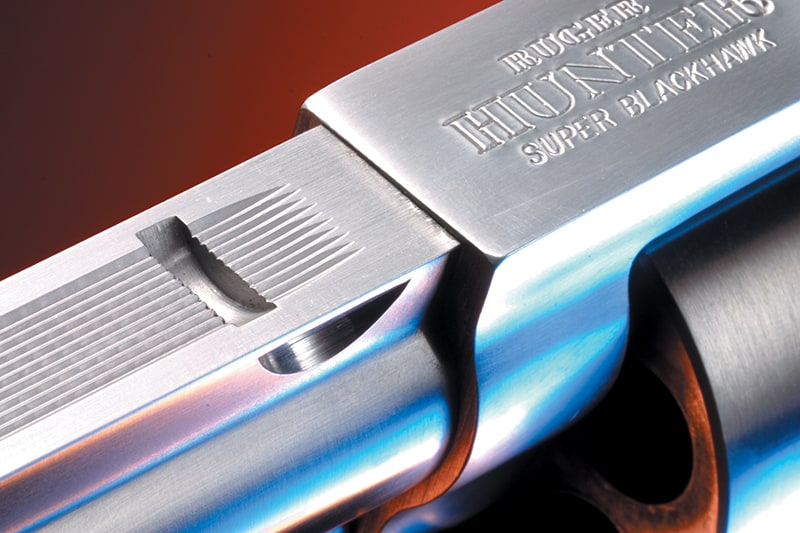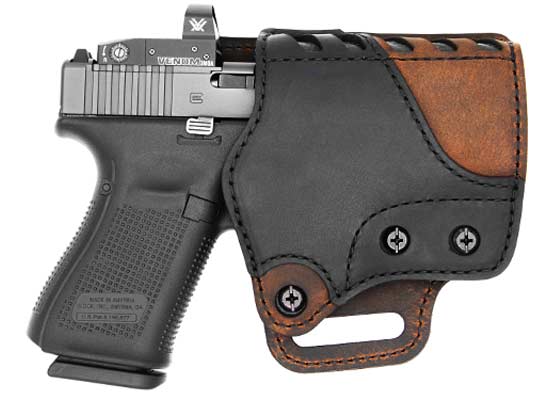Return Of The Ruger Hunter Model
In the late 1920s, Elmer Keith collaborated with Harold Croft, J.D. O’Meara, and R.F. Sedgley to come up with what he considered the perfect sixgun. Since Croft had already been experimenting with custom gunsmithing of the Colt revolver in both Bisley and Single Action models, and had numbered his special sixguns No. 1, 2, 3, and 4, Keith labeled this new creation the No. 5 SA.
Using a Colt Single Action, perhaps a Bisley Model, as the basic platform, the top strap was welded up and flat-topped; adjustable sights were fitted; and the grip frame was arrived at by combining a Bisley Model backstrap with a Single Action trigger guard. The caliber selected was the best available at the time for developing heavy handloads, the .44 Special.
For the next 30 years, Keith would write about his experiments with this particular .44 Special, as well as experiments with several other Colt SA and Smith & Wessons DA revolvers. Finally, in the mid-1950s, Remington and S&W both listened and came up with the .44 Magnum cartridge and that beautiful, original .44 Magnum sixgun now known as the Model 29.
Ruger Steals The Show
Meanwhile, the relatively new company of Sturm, Ruger had issued their first semi-automatic .22 in 1949. This was followed by the tremendously popular .22 Single-Six in 1953, and their first centerfire sixgun, the .357 Blackhawk in 1955. In producing the Blackhawk, Bill Ruger had obviously looked at such custom Colt Single Actions as Keith’s No. 5 .44 Special.
The .44 Magnum project was closely guarded by both Remington and S&W. However, Bill Ruger managed to hear about it. Several stories are told of this. One says a Ruger employee found a couple of .44 Magnum cartridges in the trash behind Remington; another says a Remington employee delivered a sack of cartridges to Bill Ruger secretly; and still another says a man stopped by Ruger’s office with five empty and mysterious cartridges headstamped “44 MAG.”
Whatever the true story may be, the genius of Bill Ruger came through, and he not only managed to build a .44 Magnum Blackhawk, he also had it on dealer’s shelves before S&W could deliver their double action .44 Magnum sixgun.
King Of Sixgun Loads
The .44 Magnum is past its 50th anniversary. Although it has been outperformed by the .454 Casull, .445 Supermag, and the .475 Linebaugh, and even by several heavy .45 Colt factory loads, the .44 Magnum remains the King of Sixgun Cartridges for two reasons.
It is the most affordable and readily obtainable big-bore magnum, and may be had in a wide variety of single action and double action sixguns. Another reason for its success is the fact that it is really the upper threshold of recoil that is controllable by most shooters. Power is more than adequate, as has been proven by taking all manner of the biggest big-game with the .44, including Alaskan Brown Bear and Africa’s Big Three of elephant, lion, and the ultimate handgun challenge from the Dark Continent, the Cape buffalo.
A Sucession Of Ruger Magnums
That first Ruger .44 Magnum Blackhawk is now known as the Flat-Top Model. It was offered in the original 6 .5 inch barrel length and also in the rare 10 inch and even less common 7.5 inch versions. It would stay in production from 1956 until 1963, when all Flat-Tops were “improved” to what is now known as the Old Model.
In 1959, the .44 Magnum Blackhawk was upgraded to the Super Blackhawk with a 7.5 inch barrel standard, a wide hammer and trigger, and a steel grip frame patterned after the Colt Dragoons of the 1850s.
With the arrival of this new Ruger, Keith said:
“This is just about what I have wanted and worked for for 40 years in a single action and by far the finest single action sixgun ever produced to my way of thinking. It embodies all my ideas of what such a gun should be for the cowpuncher, hunter, guide, or old hillbilly. It’s the culmination of a lifetime of dreams for me…. I tried to get Colt to bring out such a gun as this for over 30 years with no luck at all…. now we will show them what a single action should be and what they could have done years ago….”
In 1973, Bill Ruger instituted a major change in single action production with the New Model Super Blackhawk. Until this time, from 1839 forward, a single action sixgun could only be carried safely with an empty chamber under the hammer. Ruger’s New Model mechanism provided a transfer bar, which made it possible to safely carry a six-shot single action revolver fully loaded. All Ruger single actions became New Models in 1973.
Ten years later, the Super Blackhawk .44 Magnum would also be available in stainless steel. Then in 1985, Ruger completed the ideas of Elmer Keith for a perfect single action by changing the grip frame to a Bisley style and the Super Blackhawk was now available in a special version with a Bisley-style grip frame and hammer. For many sixgunners, this new grip frame was the best ever designed for handling heavy recoil. Both the New Model Super Blackhawk and the Bisley Model .44 Magnums remain in production to this day.
Ruger now had the Super Blackhawk available in both blue and stainless, and with a choice of a 7.5 or 10 inch barrel, as well as the blued 7.5 inch Bisley Model all chambered in .44 Magnum. What was left to offer .44 Magnum single action sixgunners?
Enter The Ruger Hunter
The answer was a single action designed specifically for handgun hunters. In 1992, Ruger first offered the Super Blackhawk Hunter Model. This version was fitted with a heavy bull barrel with an integral rib cut to accept Ruger scope rings, thus allowing this .44 Magnum to be very easily fitted with an LER scope.
The finish was stainless steel only, ideal for a hunter’s gun that might be carried in wet weather. The ejector rod and housing were also made longer than normal to assure easy removal of fired cases. The Super Blackhawk grip frame was maintained, although the square back trigger guard was rounded off for greater comfort when firing heavy loads.
This new Ruger .44 Magnum was all the handgun hunter could ask for. Ruger’s simple and rugged scope mounting system gave the gun great flexibility. If desired, or if bad weather conditions made it necessary to do so, the scope could be easily removed with no other tool than a fifty-cent piece. The scope could be replaced and would return to zero.
It was my good fortune to acquire one of the early Hunter Models and I’ve used it successfully in a number of hunting adventures. Stoked with 300 grain bullets at 1,200 fps or even faster, it is more than adequate for taking most big game cleanly.
An Unexpected Development
Now that Ruger had the near-perfect hunting handgun, they did a most unexpected thing. They removed it from production! No explanation was ever offered as to why this was done, and in the meantime, scalpers were able to get anywhere from 50 to 100 percent over the original cost as the demand for these guns far outweighed their supply. Ruger has not made many mistakes in its half-century of existence, however this was a major one. Finally, they have corrected this error and the Super Blackhawk Hunter Model is once again available.
A Smart Addition To A Great Sixgun
As far as I can tell, this newest production of the RSB Hunter is identical to the original versions. I did note a greater degree of cylinder float in my sample of the current version. This was easily corrected with a call to Belt Mountain and a request for their No. 5 stainless steel base pin to fit the Ruger Super Blackhawk.
This base pin has a head reminiscent of that found on Keith’s No. 5 SA, and is made slightly larger in diameter than the Ruger base pin. It was an easy fix to remove the old base pin and replace it with the tighter fitting Belt Mountain base pin. This is a custom feature, a do-it-yourself project that is recommended for any single action that shows excess play in the cylinder or are handicapped with a base pin that will not stay in place under recoil. Belt Mountain base pins also feature a locking Allen screw to fix them firmly in place. It’s a darn good product.
Minor Adjustments
As with many, perhaps most, factory sixguns today, this Hunter Model had a too heavy trigger pull for my tastes. I say “had” as this condition is easily remedied on New Model Rugers by removing the grip panels, and then flipping one leg of the trigger return spring from its post on either side of the grip frame. This simple operation resulted in the reduction of the trigger pull from 5.5 pounds down to a near-perfect 3.5 pounds.
For test firing hundreds of rounds in a single sitting, I found it prudent to replace the standard factory grip panels with more hand filling and secure Pachmayr rubber stocks. These same grips are also a good choice for a non-slip surface when hunting in bad weather. This is one instance where the addition of rubber grips does not detract from the appearance of the original factory sixgun as the laminated Ruger grips to my eyes are about as ugly as the proverbial mud fence. That is why my original Hunter Model wears stag grips.
As with its older brother the Super Blackhawk, the Hunter Model represents one of the best values in handguns today. We definitely get more than we pay for with any of the New Model Ruger Super Blackhawk. Bless Bill Ruger for providing excellent hunting handguns that anyone can afford to own.
Real Performer
More than 30 different heavy-duty hunting loads were tested. This included both cast and jacketed bullet loads, as well as both factory ammunition and handloads. Many of the loads grouped in the 1 inch category for five shots at 25 yards, and what really makes this sixgun special is that it showed the same high level of accuracy with a wide variety of factory and handloaded ammunition. That makes it a most versatile revolver indeed.
These results are much better than one has a right to expect with a sixgun in this price range, especially one straight out of the box. The groups were fired before the cylinder was tightened up with the addition of the Belt Mountain No. 5 base pin. It may perform even better now.
I’m not going to be bashful about this. If I’ve yet to make my feelings plain, I believe the Ruger Super Blackhawk Hunter is an outstanding bargain. It’s accurate, rugged, versatile and priced right. I suspect that handgunners will vote with their pocketbooks, and Ruger will soon realize how wise it was to return this outstanding sixgun to the marketplace.

Get More Revolver Content Every Week!
Sign up for the Wheelgun Wednesday newsletter here:











